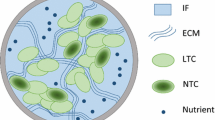3D cell cultures are extensively used to study in vitro toxic effect of xenobiotics. When using multicellular spheroids, the question about their optimal size should be solved: small spheroids are difficult to manipulate, while large size of spheroids impairs the transport of nutrients and oxygen into the center. Mathematical models describing the distribution of substances in multicellular spheroids numerical procedure for solving differential equation system, which complicates their use in laboratory practice. We proposed and experimentally evaluated a new mathematical model describing oxygen distribution in HepaRG cell spheroids. Markers of functional activity were studied in spheroids of different size. The maximum size of spheroids that can be maintained in culture for 9 days without necrosis was determined.
Similar content being viewed by others
references
P. Buchwald, Theor. Biol. Med. Model, 6, doi: 10.1186/1742-4682-6-5c(2009).
E. Curcio, S.Salermno, G. Barbieri, et al., Biomaterials, 28, No. 36, 5487-5497 (2007).
R. Glicklis, J. C.Merchuk, and S. Cohen, Biotechnol. Bioeng., 86, No. 6, 672-680 (2004).
F. P. Guengerich, Chem. Biol. Interact., 106, No. 3, 161-182 (1997).
P. Gunness, D. Mueller, V. Shevchenko, et al., Toxicol. Sci., 133, No. 1, 67-78 (2013).
D. G. Jennen, C. Magkonfopoulou, H. B. Ketelslegers, et al., Toxicol. Sci., 115, No. 1, 66-79 (2010).
E. M. Materne, A. G. Tonevitsky, and U. Marx, Lab. Chip, 13, No. 18, 3481-3495 (2013).
M. Moisenovich, A. Tonevitsky, and I. Agapov, Eur. J. Cell Biol., 81, No. 10, 529-538 (2002).
J. F. Patzer 2nd, Artif. Organs, 28, No. 1, 83-98 (2004).
S. C. Ramaiahgari, M. W. den Braver, and B. Herpers, Arch. Toxicol., 88, No. 5, 1083-1095 (2014).
G. Repetto, A. del Peso, and J. L. Zurita, Nat. Protoc., 3, No. 7, 1125-1131 (2008).
T. R. Samatov, M. U. Shkurnikov, S. A. Tonevitskaya, and A. G. Tonevitsky, Prog. Histochem. Cytochem., 49, No. 4, 21-29 (2015).
M. D. Smith, A. D. Smirthwaite, D. E. Cairns, et al., Int. J. Artif. Organs, 19, No. 1, 36-44 (1996).
B. Stoll, W. Gerok, F. Lang, and D. Häussinger, Biochem. J., 287, Pt 1, 217-222 (1992).
I. Wagner, E. M. Materne, S. Brincker, et al., Lab. Chip, 13, No. 18, 3538-3547 (2013).
Author information
Authors and Affiliations
Corresponding author
Additional information
Translated from Byulleten’ Eksperimental’noi Biologii i Meditsiny, Vol. 160, No. 12, pp. 836-840, December, 2015
Rights and permissions
About this article
Cite this article
Aleksandrova, A.V., Pulkova, N.P., Gerasimenko, T.N. et al. Mathematical and Experimental Model of Oxygen Diffusion for HepaRG Cell Spheroids. Bull Exp Biol Med 160, 857–860 (2016). https://doi.org/10.1007/s10517-016-3326-1
Received:
Published:
Issue Date:
DOI: https://doi.org/10.1007/s10517-016-3326-1




